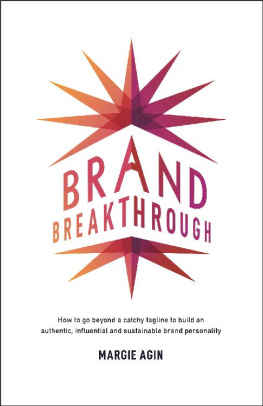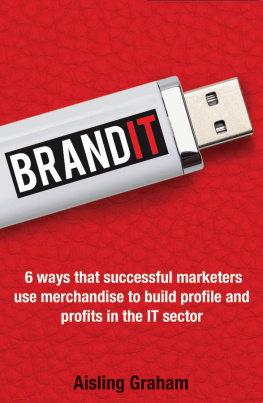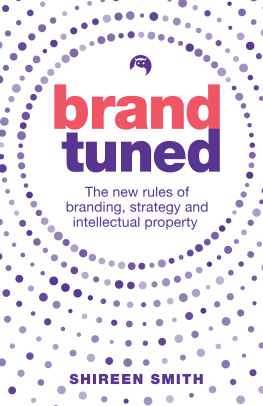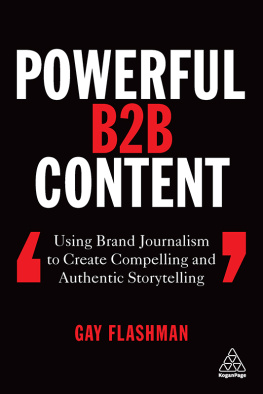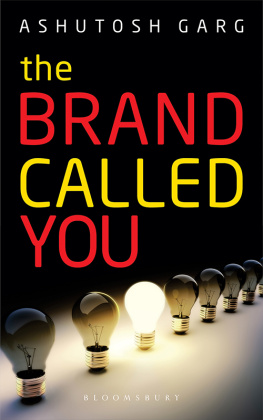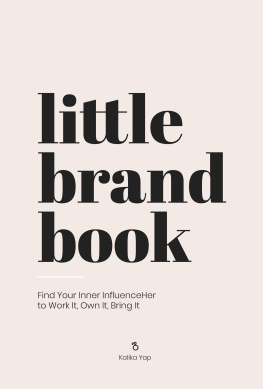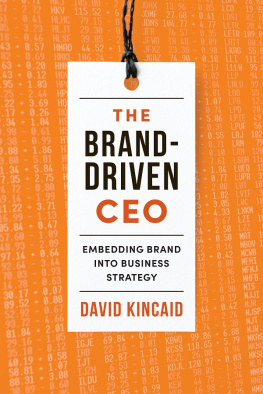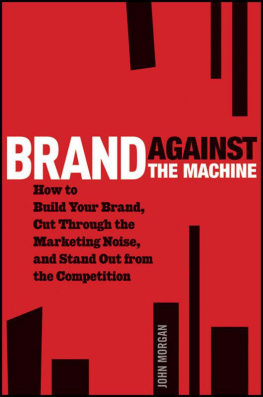How to go beyond a catchy tagline to build an authentic, influential and sustainable brand personality
All rights reserved. No part of this publication may be reproduced, distributed or transmitted in any form or by any means, including photocopying, recording or other electronic or mechanical methods, without the prior written permission of the publisher, except in the case of brief quotations embodied in reviews and certain other non-commercial uses permitted by copyright law.
.
INTRODUCTION TO BRAND PERSONALITY
Your customers dont care about you. Theyre busy, distracted people fighting to keep up in an increasingly noisy world. Many companies try to break through the noise by gettingwelllouder! With so many voices yelling at them, its no wonder people run for the hills.
Creating more content isnt the answer. These days, content must be fiercely compelling for people to read, share and link to it. When your audience has seen a similar ad, webpage or presentation 100 times before, they glaze over and your message gets lost. Over two-thirds of content never gets seen!
The world is cluttered with boring companies telling generic stories. Dont contribute to the junk pile.
Be different. Stand out. Take a stand.
The power of brand personality has helped organizations differentiate themselves, influence buyers and achieve rapid growth. Using the lessons outlined in this book, you can do the same.
Why brand personality?
Almost half of Americans and 84% of millennials mistrust brands. So, how can your brand earn their trust and communicate with them more effectively?
People buy from people. To build powerful connections with your audience, you must make your brand seem more like a persona person defined by character traits that guide how you present yourself to the world.
Even business-to-business (B2B) companies are actually people selling to people . They arent excused from having a brand personality. Throughout this book youll see numerous examples that demonstrate how B2B companies use brand personality to their advantage.
Elements of brand personality
An authentic brand personality builds a genuine connection between a company and its customers based on open, honest communication. Your brand personality is intrinsic to your organization. It reflects your company culture and the experience you create for everyone interacting with you.
Brand personality isnt simply about visual brand identity (logo, colors, photography, etc.). Those things are important elements that support your brand, but they come after your core brand personality is defined. If youve ever been handed a beautifully designed webpage with Lorem Ipsum copy as a placeholder, you know what Im talking about. You cant just fill the blank spaces on that page with any old copy.
The strongest, most persuasive brand personalities employ carefully selected messages and language to build authority and connect with customers emotionally and intellectually.
In this book well break down the process of developing a brand personality into a step-by-step playbook. Well focus on how your brand personality impacts what you say and how you say it .
- What you say includes marketing messages, promises and examples.
- How you say it refers to language choices, tone and format.
Who is this book for? Who should care about brand personality?
Marketing teams are typically considered the caretakers of the companys brand because theyre responsible for producing and distributing the vast majority of content. In most cases, the marketing team does the work to articulate and document the brand personality.
But branding isnt something that should be discussed in the vacuum of a marketing meeting and then get handed down from the mountaintop to the rest of the organization. The most consistent brands reflect all areas of a company and are built with input from different groups.
Company leaders
When a company is in high growth mode, its culture is most at risk. Its a vital time for leaders to understand and articulate the company culture they want to maintain. In the same vein, this is the time when customer loyalty presents the most risk and the most potential. If you can consistently convey an authentic brand personality even as your company grows, you can retain customers and turn them into passionate brand advocates, with measurable impact on revenue.
Sales teams
Sales teams have an incredibly important role in defining and maintaining a companys brand. Theyre the voice and face of the organization and must embody the brand in the words they choose and the actions they take. During the brand development process, part of their role is to be a conduit for communication between customers and the rest of the organization. A salesperson can tell if brand messages are getting customers excited or if the messages are falling flat.
Product and technical teams
Most technical folks, developers and engineers spend their time ensuring things work, not thinking about how people feel about their experience. But if you have a tangible product youre sellinghardware, software or consumer goodthe experience customers have with that product is a component of your brands personality. Lets say a company wants its brand to embody simplicity. A user interface thats complex and messy reflects poorly on the brand.
Human Resources teams
In a tight job market, HR teams need to consider the talent brand of their organization as part of their recruiting and retention strategies. People are increasingly looking for work that makes an impact. According to the 2018 Global Brand Health Report , companies that communicate their brand personality get more attention from potential employees.
Anyone who writes or hires writers
On a practical level, creating and documenting your brand personality saves time creating sales and marketing materials. Once you have defined your brand personality and created guidelines and parameters, you can hand off to content creators and they can start creating without having to reinvent the wheel. That includes copywriters, technical product writers, social media managers, email marketers and SEO specialists.
Visual and UX designers
Logos, colors, typeface, photography and page layout choices need to be in synch with your brand personality. For example, you dont want to marry a cartoon-like graphic style with a serious tone of voice in your writing. Designers must intimately understand the traits of the brand personality to do their work.
Whats different about this approach to branding?
This book was born from a personal frustration with the gap between top-down brand strategy and consistent, sustainable execution.
Most brand projects operate in what I think of as the brand stratosphere. They take a 10,000-foot view of brand from the top down. Their main goal is to build awareness, or what is sometimes called air cover, for the rest of the organization to do the so-called real work.
I dont come from that world. I came to brand marketing from the ground up. I started out in market research, which is about as ground up in the marketing world as you can get. I was on the phone, interviewing business leaders, engineers, purchasing agents and other decision makers about how they select and use products. I learned to talk to basically anyone about basically anything, from HR software to milking machines, and find patterns and hot buttons to transform into marketing messages.

